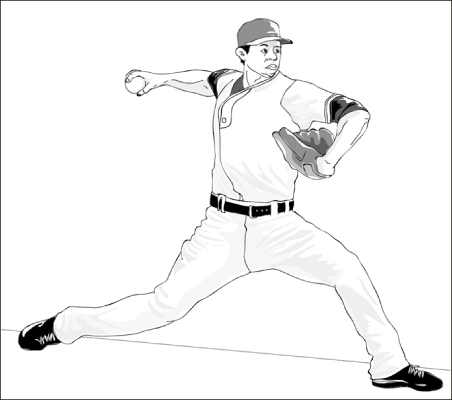Korean J Sports Med.
2019 Dec;37(4):130-133. 10.5763/kjsm.2019.37.4.130.
Is Hyperabduction Arm Position in Early Cocking Phase Really Dangerous for Baseball Pitchers?
- Affiliations
-
- 1Center for Shoulder, Elbow and Sports, Neon Orthopaedic Clinic, Seoul, Korea.
- 2Department of Orthopaedic Surgery, Konyang University Hospital, Daejeon, Korea. ossurgeon@kyuh.ac.kr
- 3Professional Baseball Team, Doosan Bears, Seoul, Korea.
- KMID: 2466801
- DOI: http://doi.org/10.5763/kjsm.2019.37.4.130
Abstract
- PURPOSE
Certain pitching mechanics is thought to lead pitchers in danger of surgical risk and decrease performance. The objective of this study is to analyze the effect of shoulder hyperabduction position during early cocking phase in association with surgical risk and performance in professional baseball players.
METHODS
From 2009 to 2013, total of 93 candidates reached minimum inning qualification. After exclusion criteria (overlapped players, foreign players, age over 31 years, proceed to other league and retirement), 19 players were analyzed with slow-motion pitching video for hyperabduction of the shoulder and hyperpronation of forearm in cocking-phase. Also players were analyzed with innings pitched, earned run average (ERA), walks and hits divided by innings pitched (WHIP) and surgical history with database offered by official Korean Baseball Organization website.
RESULTS
Out of total 19 players, nine players had hyperabduction arm movement and 10 players did not. Group with hyperabduction had average age of 24.3 years old, average inning/ERA/WHIP for 5 years were 55 innings/yr, 6.52 ERA/yr and 1.33 WHIP/yr, respectively, and seven players (77%) had surgeries eventually. Group without hyperabduction arm movement had average age of 25.4 years old; average inning, ERA/WHIP for 5 years were 127 1/3 innings/yr, 4.84 ERA/yr, and 1.32 WHIP/yr, respectively and five players (50%) went for surgeries. Player performance (ERA, p=0.66; WHIP, p=0.14) was not statistically influenced by the certain arm position at cocking phase but average inning pitched was statistically affected (p<0.01).
CONCLUSION
Hyperabduction of shoulder in early cocking phase of throwing motion does not lead to decrease in performance (ERA, WHIP) but will result in tremendous decline of average IP. Also, risk of surgery is not associated to hyperabduction motion of the shoulder.
Keyword
Figure
Reference
-
1. Posner M, Cameron KL, Wolf JM, Belmont PJ Jr, Owens BD. Epidemiology of major league baseball injuries. Am J Sports Med. 2011; 39:1676–1680.2. Lyman S, Fleisig GS, Andrews JR, Osinski ED. Effect of pitch type, pitch count, and pitching mechanics on risk of elbow and shoulder pain in youth baseball pitchers. Am J Sports Med. 2002; 30:463–468.3. Davis JT, Limpisvasti O, Fluhme D, et al. The effect of pitching biomechanics on the upper extremity in youth and adolescent baseball pitchers. Am J Sports Med. 2009; 37:1484–1491.4. O'Leary C. Pitching mechanics 101 [Internet]. ChrisOLeary. com;cited 2019 Nov 7. Available from: http://chrisoleary.com/projects/PitchingMechanics101/index.html.5. Aguinaldo AL, Chambers H. Correlation of throwing mechanics with elbow valgus load in adult baseball pitchers. Am J Sports Med. 2009; 37:2043–2048.6. Douoguih WA, Dolce DL, Lincoln AE. Early cocking phase mechanics and upper extremity surgery risk in starting professional baseball pitchers. Orthop J Sports Med. 2015; 3:2325967115581594.7. Anz AW, Bushnell BD, Griffin LP, Noonan TJ, Torry MR, Hawkins RJ. Correlation of torque and elbow injury in professional baseball pitchers. Am J Sports Med. 2010; 38:1368–1374.
- Full Text Links
- Actions
-
Cited
- CITED
-
- Close
- Share
- Similar articles
-
- A Clinical Study on Baseball Pitcher's Elbow
- The Findings of Physical Examination and Ultrasonography at the Shoulders in High School Baseball Players
- Little Leaguer Shoulder with Contralateral Thrower's Fracture of the Humerus in Adolescent Baseball Pitchers
- Characteristics of Lumbar Spondylolysis in Adolescent Baseball Players: Relationship between the Laterality of Lumbar Spondylolysis and the Throwing or Batting Side
- Sonoelastography on Supraspinatus Muscle-Tendon and Long Head of Biceps Tendon in Korean Professional Baseball Pitchers




